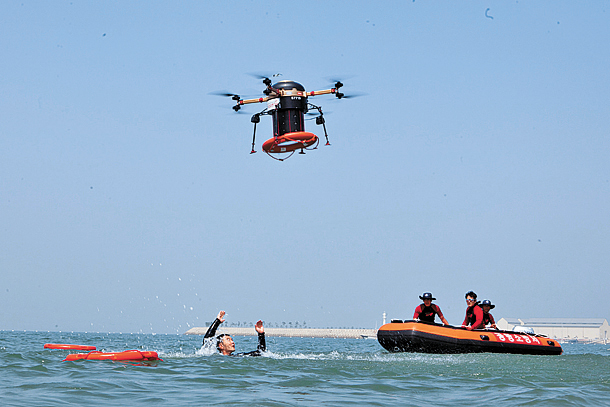SKT reveals disaster relief drones
Published: 16 Jul. 2017, 18:45

Local drone maker Soomvi’s rescue drone drops a life preserver to a drowning person during a service simulation event held Friday at Eurwangni Beach in Incheon. The drone is mounted with a live video encoder developed by SK Telecom for real-time video transmission to control centers. [SK TELECOM]
“Stay calm and we will deliver you the tube!” a voice rang out as a large drone holding three life preservers flew toward a man floundering in the sea on Friday. Just 40 seconds after the 41-kilogram (90-pound) drone took off from its base-station on the beach, it reached the drowning man and delivered a life preserver.
The display on Friday was a demonstration of SK Telecom’s new disaster management system, which the top carrier announced it had developed in hand with local drone maker Soomvi.
While Soomvi has been developing industrial drones for marine rescue since its founding in 2015, SK Telecom’s LTE network and its newly developed live video encoder “T Live Caster” have enabled Soomvi to monitor target areas from a control center in real-time.
Video encoders compress captured video so it can be sent via the internet to broadcasting devices.
Existing drones are limited to delivering video within a three kilometer (1.86 mile) radius around control centers, as they usually rely on radio frequencies to transmit videos. However, SK Telecom’s video encoder enable drones to transmit video from any location, as the encoder works on the LTE network established nationwide, the carrier said.
Also, while most of the video transmitting equipment weighs over 1 kilogram, which makes it hard to mount on flying drones, the mobile carrier’s equipment weighs only 140 grams, one fifth of existing devices.
“There were video transmitters in the past with similar functions, however, the new product from SK Telecom is different in that it enables direct transmission of video to control centers without sending video to ground repeaters then sending it via LTE to control centers,” said Youn Jong-pil, team leader of the IoT business division at SK Telecom.
As such, the system enables faster and more convenient delivery of drone-captured videos to control centers.
“We also used application processors used in smartphones instead of processors commonly used for broadcasting equipment,” Youn added. “That’s how we made our transmitter lighter, cheaper and compact compared to those already on the market.”
T Live Caster costs around 3 million won ($2,643), compared to the 20 million won devices offered by competitors, SK Telecom said in a statement.
SK Telecom and Soomvi are first utilizing the drones in the skies of Incheon to monitor the safety of fishing boats and fine dust levels.
They are in discussion with more local governments and beach operators to expand service partnerships.
When the next generation 5G network is commercialized, SK Telecom predicts its network-powered drones will also be able to effectively respond to natural disasters.
The mobile carrier is also eyeing live broadcasting of sport events via drone.
SK Telecom uses two different industrial drones from Soomvi for its disaster management program. One is an aerial recording and monitoring drone that flies around a target area to warn people of possible danger and spot lost children via its face-recognition function.
The other is the life-preserver-carrying rescue drone that is designed to deliver rescue apparatus to drowning people as fast as possible.
According to the drone maker, the marine rescue drone delivers life preservers in an average of 24 seconds based on data accumulated through trials. Generally, a drowning person must be rescued in about 2 minutes.
The two companies also developed a moving control center in a five-ton container truck called the “Drone Mobile Station.”
The moving control center was necessary to overcome the limits of drone batteries, which run for a maximum of 40 minutes at full charge.
The truck is equipped with drones, wireless charging stations and nine monitors that show live video streams from the drones.
BY KIM JEE-HEE [kim.jeehee@joongang.co.kr]










with the Korea JoongAng Daily
To write comments, please log in to one of the accounts.
Standards Board Policy (0/250자)